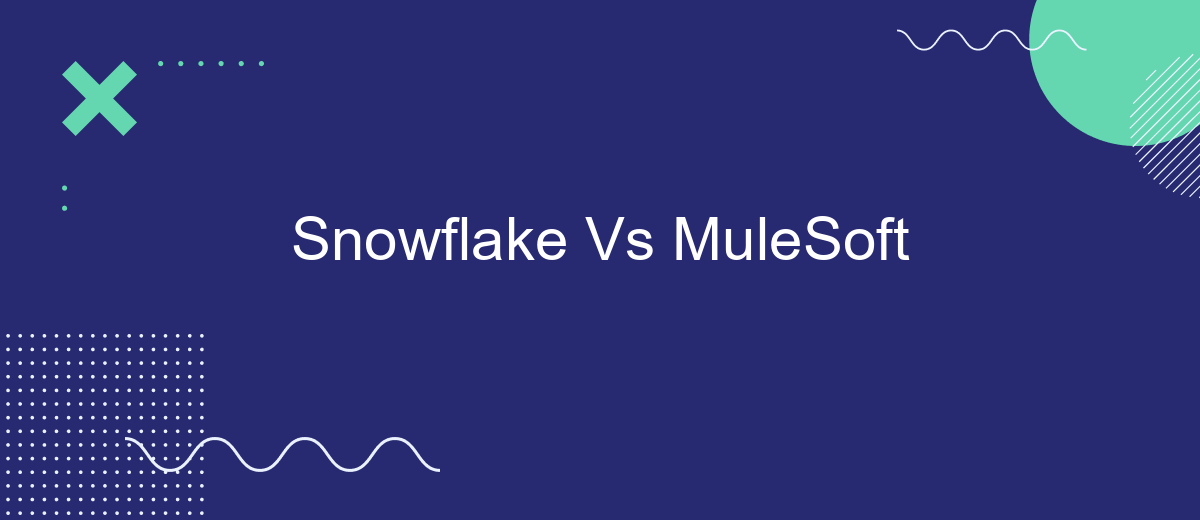In today's rapidly evolving digital landscape, businesses are increasingly relying on robust data integration and management solutions to stay competitive. Two prominent players in this field are Snowflake and MuleSoft. This article delves into a comparative analysis of these platforms, exploring their unique features, strengths, and potential use cases to help organizations make informed decisions about their data strategy.
Snowflake vs MuleSoft
Snowflake and MuleSoft serve different purposes but are often used together to create robust data integration solutions. Snowflake is a cloud-based data warehousing platform that allows businesses to store and analyze large volumes of data efficiently. MuleSoft, on the other hand, is an integration platform that enables companies to connect various applications, data, and devices seamlessly.
- Snowflake: Cloud-based data warehousing and analytics platform
- MuleSoft: Integration platform for connecting applications, data, and devices
- SaveMyLeads: Service for setting up integrations without coding
While Snowflake excels in data storage and analytics, MuleSoft provides the necessary tools to integrate that data with other systems. SaveMyLeads can further simplify this process by offering a no-code solution to set up integrations between Snowflake, MuleSoft, and other services. This combination allows businesses to harness the full potential of their data, ensuring seamless workflows and efficient data management.
Architecture

Snowflake’s architecture is designed to handle large-scale data warehousing and analytics. It separates storage and compute, allowing for independent scaling of each. This architecture consists of three main layers: Database Storage, Query Processing, and Cloud Services. Database Storage handles data storage using a columnar format, optimizing for both performance and cost. Query Processing involves multiple virtual warehouses that can scale up or down based on demand, ensuring efficient query execution. The Cloud Services layer manages metadata, authentication, and infrastructure optimization, providing a seamless user experience.
MuleSoft, on the other hand, focuses on integration and API management. Its architecture is built around the Anypoint Platform, which offers tools for designing, building, and managing APIs and integrations. MuleSoft’s runtime engine, Mule, enables the execution of integration flows and supports various data formats and protocols. For businesses looking to streamline integrations, services like SaveMyLeads can be invaluable. SaveMyLeads offers pre-built connectors and automation tools that simplify the integration process, making it easier to connect disparate systems and enhance data flow across platforms.
Capabilities

When comparing Snowflake and MuleSoft, it's essential to understand their unique capabilities. Snowflake is a cloud-based data warehousing solution that offers scalable storage and compute resources. MuleSoft, on the other hand, is an integration platform that connects various applications, data, and devices through APIs.
- Data Storage and Processing: Snowflake provides efficient data storage, enabling users to handle large volumes of data with ease. MuleSoft focuses on seamless data integration across different systems.
- Scalability: Snowflake's architecture allows for automatic scaling to meet changing workloads, while MuleSoft provides scalable API management solutions.
- Integration: MuleSoft excels in connecting disparate systems, making it easier to integrate data from various sources. Snowflake offers robust data sharing capabilities but relies on integration tools like MuleSoft or SaveMyLeads for comprehensive data connectivity.
In summary, Snowflake is ideal for organizations needing powerful data warehousing and processing capabilities, while MuleSoft excels in facilitating integrations across multiple platforms. Combining both can create a robust data ecosystem, enhanced further by tools like SaveMyLeads for streamlined data integration processes.
Pricing

When comparing Snowflake and MuleSoft, pricing is an essential factor to consider. Both platforms offer different pricing models tailored to meet diverse business needs. Snowflake operates on a consumption-based pricing model, which means you only pay for the storage and compute resources you use. This can be highly cost-effective for businesses with variable workloads.
On the other hand, MuleSoft offers subscription-based pricing, which can be more predictable for budgeting purposes. MuleSoft's pricing is based on the number of integrations, APIs, and the level of support required. This model can be advantageous for organizations with steady integration needs.
- Snowflake: Consumption-based pricing
- MuleSoft: Subscription-based pricing
- SaveMyLeads: Affordable integration automation
For companies looking to streamline their integration processes, services like SaveMyLeads can offer a cost-effective solution. SaveMyLeads provides an automated integration setup, which can save both time and money, making it an excellent complement to either Snowflake or MuleSoft depending on your specific needs.
Use Cases
Snowflake is widely used in data warehousing and analytics scenarios. It allows businesses to handle large volumes of data with ease, providing scalability, flexibility, and powerful performance. Companies leverage Snowflake for complex data processing tasks, real-time data analytics, and seamless data sharing across departments. Its cloud-native architecture makes it an ideal choice for organizations looking to modernize their data infrastructure and support advanced analytics initiatives.
MuleSoft, on the other hand, excels in integration use cases, enabling businesses to connect disparate systems and applications efficiently. It supports API-led connectivity, allowing for seamless data flow between on-premises and cloud environments. MuleSoft is often used in scenarios where companies need to integrate various enterprise systems, automate business processes, and ensure real-time data synchronization. For instance, services like SaveMyLeads can benefit from MuleSoft to streamline the integration of lead generation platforms with CRM systems, enhancing lead management and improving sales outcomes.
FAQ
What are the primary differences between Snowflake and MuleSoft?
Can Snowflake and MuleSoft be used together?
Which platform is better for real-time data integration?
Is it possible to automate data workflows between Snowflake and other applications?
What are the typical use cases for Snowflake and MuleSoft?
If you use Facebook Lead Ads, then you should know what it means to regularly download CSV files and transfer data to various support services. How many times a day do you check for new leads in your ad account? How often do you transfer data to a CRM system, task manager, email service or Google Sheets? Try using the SaveMyLeads online connector. This is a no-code tool with which anyone can set up integrations for Facebook. Spend just a few minutes and you will receive real-time notifications in the messenger about new leads. Another 5-10 minutes of work in SML, and the data from the FB advertising account will be automatically transferred to the CRM system or Email service. The SaveMyLeads system will do the routine work for you, and you will surely like it.
